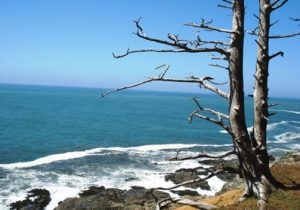
Gray, Humpback and Sperm Whales can be observed at any time along the south Oregon and northern California coast, but the most active time is during the winter and spring migrations, from November through early April. Winter migration peaks in late December while the spring migration peaks in March. During the summer months, hundreds of Gray Whales remain along the coast and may be seen at any time.

Look for the subtle ‘spouts’ in the water. It is not unusual to see several whales frolicking in the surf, easily observable from Route 101. Lucky observers may get to see a breach (head straight up in the water) and flukes or tails of these amazing mammals.
There are nine places on the coast that have been designated as whale watching sites. Volunteers man these sites during the winter and spring migrating season, from 10 am to 1 pm. These are (from north to south):
1) The Umpqua lighthouse, located south of Reedsport near Winchester Bay.
2) Shore Acres State Park, located west of Coos Bay, near Charleston.
3) Face Rock Wayside State Scenic Viewpoint
4) Cape Blanco Lighthouse, near Cape Blanco State Park
5) Battle Rock Wayfinding Point, Port Orford
6) Cape Sebastian
7) Cape Ferrelo
8) Harris Beach State Park, Brookings
9) 9th Street Beach, Crescent City, California
10) Patrick Points State Park (25 miles north of Eureka)

Volunteers are present during the whale watch weeks. Winter watch week is after December 25 through Jan. 1, while the spring migration observation takes place during the last week of March. Look for the “Whale Watching Spoken Here” informational guides. While these are the only weeks when volunteers are present to assist, whales may be observed in large numbers before and after the whale watch weeks, and at any time in smaller numbers throughout the spring, summer and fall.
Statistics have been kept for the number of whale spotted at each site during whale watching week. While the numbers could vary depending on the number of whale watching volunteers and the weather, there are frequently more whales spotted at Cape Ferrelo than any other site in the state. Close behind was Shore Acres.
Whale watching hints:
* Gray whales usually surface every 40 – 50 seconds as they swim, but will often stay under for 3 to 5 minutes while they are eating. If they have been under for 5 minutes, they usually blow 5 times when they surface to restore their oxygen supply.
* The goal is to spot a breach – when the whale launches up to 3/4 of their body into the air.
* A deep dive, known as sounding or fluking, happens when a whale lifts its tail out of the water. This helps the whale dive at a steep angle in order to feed. Look for the ‘fluke-print’ which occurs from the water turbulence caused by this dive.
* Gray whales often lift their heads above the surface in order to get a better sense of their surrounds. This is known as ‘spyhopping’.
* It is easy to spot a whale during morning night. Afternoon light reflects off the water making viewing more difficult.
* Higher locations such as capes are better viewpoints.
For a brochure, download this PDF.
